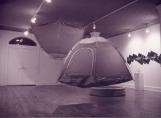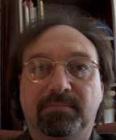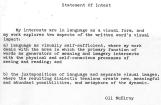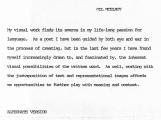1
Gilbert McElroy, who goes by the name of Gil, was born in 1956 in Metz, France, as Gilbert Andrew McElroy. He is the eldest of four children. As a result of air force relocations, he spent his childhood in Metz, France (1956-1957), Chatham, New Brunswick and St. Margaret's, New Brunswick (1957-1961), Beaverbank, Nova Scotia (1961-1963), Tacoma, Washington (1963-1967), Windsor (1967), and North Bay, Ontario (1967-1975).In 1975, he moved to Hamilton, Ontario, where he studied English literature at McMaster University for one year. He moved to Kingston, Ontario in 1976, where he studied English literature from 1976 to 1978. In 1979, he moved to Windsor, Ontario where he worked as a writer. The same year, he moved to North Bay, Ontario, where he worked as a museum director/curator in nearby Callander. In 1990, he moved to Halifax, where he worked at the Art Gallery of Nova Scotia. In 1997, he moved to Charlottetown, Prince Edward Island, where he was curator and education coordinator for the Confederation Art Gallery & Museum from 1997 to 2000. In 2000, he and Heather Ann Sudds (whom he married in 2001 and has three children with) moved to Colborne, Ontario, where they currently reside. From 2004 to 2005, he was acting curator at the Robert McLaughlin Gallery in Oshawa, Ontario. In 2006, he became the interim curator at the Station Gallery in Whitby, Ontario.
He served on the board of White Water Gallery in North Bay from 1984 to 1988.
Solo exhibitions of his work include Memory Tables (1996, Struts Gallery, Sackville, New Brunswick), Fos (Light), (1994, OO Gallery, Halifax, Nova Scotia), Calendar Room (1992, White Water Gallery, North Bay and Struts Gallery, Sackville, New Brunswick), AB&C's: Possession is 9/10's of the Law (1990, North Bay Arts Centre, Ontario), peeces (1989, White Water Gallery, North Bay, Ontario), and Claim Trails, Lake Nipissing (The Lake Script) (1987, North Bay Area Museum, North Bay, Ontario).
He has curated projects for The Robert McLaughlin Gallery in Oshawa (2008, 2005), the Station Gallery in Whitby (2008, 2007, 2006), the W. K. P. Kennedy Gallery in North Bay (2005), the Art Gallery of Nova Scotia (2003, 1998, 1995), the Owens Art Gallery in Sackville, New Brunswick (2003), the Confederation Centre Art Gallery & Museum in Charlottetown, Prince Edward Island (2001, 2000, 1999, 1998), the Acadia University Art Gallery in Wolfville, Nova Scotia (1999), and the School of Architecture, Technical University of Nova Scotia in Halifax (1996).
He is the author of Gravity & Grace: Selected Writings on Contemporary Canadian Art (Wolfville, NS: Gasperau Press). His critical writing has appeared in the following periodicals: Afterimage (US); American Ceramics (US); Art Gallery of Nova Scotia Journal; Art on Paper (US); Art Papers (US); Artichoke; Artists in Canada (online); ARTSAtlantic; Atlantic Books Today; Border Crossings; C; Ceramics: Art + Perception (Australia); Contact; Critical Ceramics (US, online); Espace; Extension; Fibrearts (US); Fusion; Ontario Craft; Parallelogramme; Sculpture (US); Surface Design Journal (US); UbuWeb: Visual, Concrete + Sound Poetry (US, online); Visual Art News. He has written non-curatorial catalogue essays for Rebecca Gallery (2006, Toronto), Artcite (2006, Windsor), Hamilton Artists Inc. (2006, Hamilton, Ontario), W. K. P. Kennedy Gallery (2005, North Bay, Ontario), McMaster University Art Gallery (2004, Hamilton, Ontario), Tree Museum Collective (2003, Toronto, Ontario), Grimsby Art Centre (2002, Grimsby, Ontario), Acadia Art Gallery (1999 and 1997, Wolfville, Nova Scotia), and Moose Jaw Art Museum (1997, Moose Jaw, Saskatchewan).
His literary writings are featured in periodicals, anthologies and in his books, NonZero Definitions (2004: Vancouver, Talonbooks) and Dream Pool Essays (2001, Vancouver, Talonbooks).
He has received the following grants: Canada Council of the Arts mid-career grant (2006), Ontario Arts Council works in progress grant (2002), Canada Council travel grant to professional artists (2000), Canada Council travel assistance grant (2000), Nova Scotia Department of Education and Culture exhibition assistance grant (1996), Ontario Arts Council short term grant (1990), Ontario Arts Council exhibition assistance grant (1990), and Ontario Arts Council Writers' reserve grant (1990, 1989, 1986, 1981).
His work is held in the collections of the Nova Scotia Art Bank; Ontario Northland Transportation Commission; and the W. K. P. Kennedy Gallery.
(The biographical information featured here was written in consultation with the artist in 2006.)
Interview:
Q: You work in multiple media; do you have a favourite?
A: When I was doing a great deal of work on paper, I became quite partial to oil pastels. I also worked extensively drawing with a blowtorch, creating images of astronomical objects like galaxies that were akin to photographic negatives - the background, the whiteness of paper, the object of interest varying shades of the darkness of scorched or downright burned paper. It was, I think, a medium perfectly suited to the concept.
My interests have shifted more towards gallery- and site-specific installations, but I still work with whatever is best suited to the concept at hand - to borrow from the late poet Robert Creeley, form is never more than an extension of content. For a recent group show at Lonsdale Gallery in Toronto, I contributed a small work on paper, but for a two-person collaborative exhibition I'm doing with Halifax artist Peter Dykhuis, the conceptual needs of the show (which is based on the social and historical impact of the squadron of nuclear-tipped BOMARC missiles stationed in North Bay during the 1960s and early 1970s) determine a very different approach.
Q: When did your interest in cosmology begin and when did it start to influence your work?
A: I've been interested in astronomy since I was eight or nine, when I was given a small telescope for Christmas. But my interest really blossomed in the mid-1980s. For a city its size, North Bay had remarkably dark skies, and I was able to do a lot of observational astronomy from the downtown area where I lived. When I moved to Halifax in 1990, that all but ended owing to the city's heavy light pollution. I became more and more engrossed in the more theoretical aspects of how our universe came into being: in the discipline of cosmology. It is easily my most intense interest, and of course enters into my poetry, my visual art, and even my curatorial work.
Q: Did being a "military brat" affect your life and artwork?
A: Absolutely. When I mounted a site-specific, installation show at Struts Gallery in Sackville, New Brunswick in the early 1990s, for instance, I was able to disembark from the train from Halifax carrying everything I needed under both arms. That was important to me. I have an intense aversion to creating anything that is not easily transported. I know other artists whose work I think has been shaped by this same life-experience - Cliff Eyland, all of whose paintings are the size of an index card, comes immediately to mind. By my last count, I've lived in 25 different homes in the course of a half-century (14 of those during my air force brat childhood), so it can't help but be a factor shaping the kind of work I do as it has inevitably shaped the kind of person I am.
It has also affected my curatorial work, as I've organized exhibitions in which visual art is contextualized by military technologies like camouflage and radar. I've done shows at the Confederation Centre Art Gallery in Charlottetown, the Owens Art Gallery in Sackville, New Brunswick, and The Robert McLaughlin Gallery in Oshawa, and worked with artists like Adrian Göllner, Peter Dykhuis, Barb Hunt, and Sarah Beck, where such concerns are at the curatorial fore - and I'm certain it can all be traced back to my father's life in the military, his early involvement with radar during WWII, and even the civilian years (all twenty of them) he spent on the DEW Line. And like him, I have an interest in and (not uncritical) appreciation of military aircraft, despite my own terror of flying (which I didn't inherit from my father, who adored it).
Q: How do you find inspiration?
A: I very rarely sit down to write a poem, for instance, with some predetermined idea in my mind. I begin, rather, with the line, and the poem progresses from, or evolves out of, that initial decision. In art making, I start with a concept that I then seek to flesh out, and material and making will have their say as the work progresses. With some works, it can take years to find the right materialization. My 1996 work Dream Pool Essays (as opposed to the book of poems published in 2001 with the same title) done at eye level gallery in Halifax comprised, in part, an installation using two self-supporting tents, both of which were suspended from the ceiling by fishing line and fish hooks, one of them upside down, and a small child's plastic pool filled with water above which hung a plumb bob which only just touched the surface of the water. The piece was the culmination of an idea I'd have five years previous based on the cosmology of a tribe in South America who believed the universe to be spindle-shaped. It took that long to figure out how to express this materially. Maybe I'm just slow. I've notebooks full of ideas for installations and site-specific pieces. Finances and/or lack of a site can ensure they don't materialize soon - if ever.
Q: Other than your art and poetry, what other interests do you have?
A: Spending time with Heather, my wife, is at the top of my list. Our time together is enormously precious, more so as we get older.
I read a great deal, almost exclusively non-fiction and poetry. I am also a licensed amateur radio operator, and have a small station at home. I'm partial to Morse Code. It's an admittedly archaic form of communication, but one which enables me to communicate with amateur radio operators around the world, many of whom I share no common language with other than an internationally recognized system of letter groups developed for Morse Code (or "CW," as it's called by amateurs).
Q: Where do you usually write your poetry?
A: At home, at my desk, at a computer. I can't write poetry long-hand - I need to be able to see the words more formally. But I keep journals of poem ideas, sketches for poems (occasionally written behind the wheel of the car), and accumulations of lines, images, etc. that I use as the material for poems I will later write.
Q: What do you remember about poetry in school when you were a child? Was this where you became interested in poetry?
A: I have always loved reading. As a child it became a safe haven for me, as did the school library during the years I was badly bullied (and so a much needed acknowledgement of and thank-you to Ruth Thib, who created a sanctuary for a lot of kids just like me in her library at Marshall Park School in North Bay in the late 1960s - God bless her for saving us). But my only childhood memory of poetry involved the need to memorize a certain number of lines of verse for my teacher, and how I would seek out poems with the shortest lines to accomplish what was to me a hateful task.
My first real encounter with poetry came in high school. I spent the winter of Grade 11 reading Dante's Divine Comedy during my lunch hour. It's from that, I think, that my career as a poet springs. But I didn't write my first true poem (one that wasn't a blatant imitation or rip-off of someone else's) until I was in university.
Q: Who are some of the artists that have inspired you?
A: William Blake would absolutely be at the top of the list - a poet and artist who married the forms and produced remarkable work. Seeing the exhibition of his paintings, drawings and etchings at the Art Gallery of Ontario in the early 1980s was a profoundly altering experience. But I'd also have to include the art and writing of Robert Smithson, and the poetry of Charles Olson, Jack Spicer, the French and Spanish Surrealists, and the work of many of the L=A=N=G=U=A=G=E writers.
I'm currently curating an exhibition for the Robert McLaughlin Gallery in Oshawa that links mid-twentieth century abstract painting with an early-twentieth century form of visually disruptive camouflage used on military and at-risk merchant ships that was called "Dazzle" and which shared many of the same conceptual and optical aims as abstract art. Doing the research for the show has reawakened my passion for the work of Canadian artists like Guido Molinari, Claude Tousignant, Agnes Martin, and Gershon Iskovitz, all of whom were early and formative influences as I became increasingly involved in visual art in the 1970s.
(Interview with Kathryn Copeland in December, 2006).
3
Gil McElroy, Dream Pool Essays (installation view), mixed media1995
eyelevel gallery, Halifax, Nova Scotia, Canada
 Credits:
Credits:courtesy of eyelevel gallery


